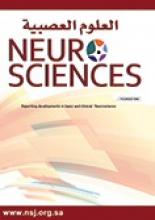Abstract
OBJECTIVE: A study of multiple sclerosis patients admitted to Jordan University Hospital over a 10-year-period with a comparison with other Western and Middle Eastern series.
METHODS: The case notes of 32 patients with multiple sclerosis were reviewed to determine the age and sex distribution, clinical findings and results of investigations, treatment and outcome.
RESULTS: There were 32 patients (24 females, 8 males, 3:1), with mean age at onset of 31.4 years, and range 6-50 years. All patients fulfilled Poser’s criteria for multiple sclerosis. The most common clinical manifestation was myelopathy followed by a polysymptomatic onset. Two-thirds of the patients had a relapsing - remitting course. The yield of cerebrospinal fluid oligoclonal banding was low (20%). The sensitivities of visual evoked potential was 62%, magnetic resonance imaging of brain 100%, magnetic resonance imaging of cervical spine was 70% and of dorsal spine 44%. Intravenous methylprednisolone Igr for 3-5 days was efficient in acute relapses for all patients. Beta-interferon was efficient in 2 out of 7 patients. After a mean follow-up of 5 years, two-thirds of the patients had mild to moderate disability (Extended disability status scale = 2 and 3).
CONCLUSION: The age and sex distribution, clinical and magnetic resonance imaging findings were almost similar to other reports. However the yield of visual evoked potentials was low and that of cerebrospinal fluid oligoclonal banding was very low, the results of treatment with beta-interferon were modest and the outcome at a mean follow-up of 5 years was relatively good.
- Copyright: © Neurosciences
Neurosciences is an Open Access journal and articles published are distributed under the terms of the Creative Commons Attribution-NonCommercial License (CC BY-NC). Readers may copy, distribute, and display the work for non-commercial purposes with the proper citation of the original work.






